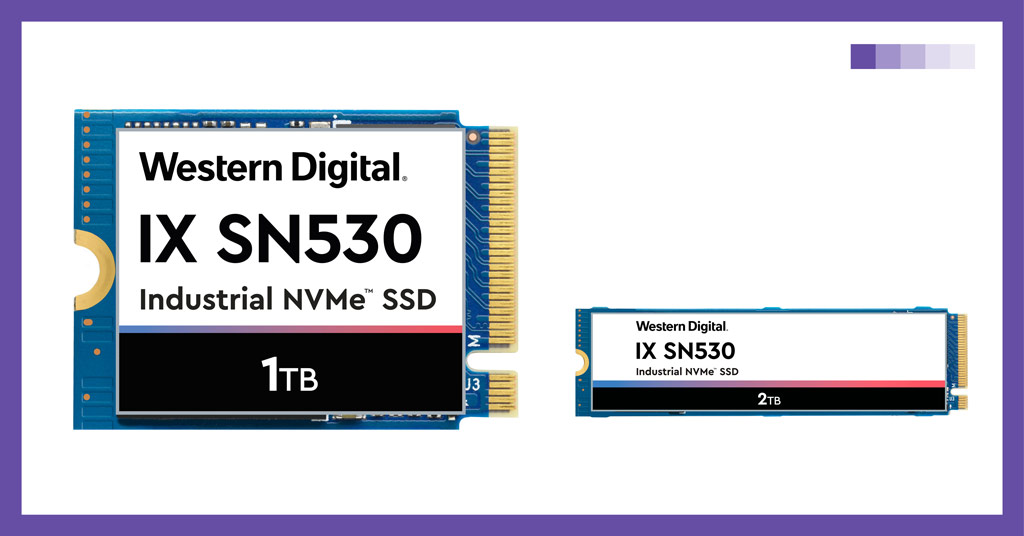Today at Flash Memory Summit, Western Digital introduced the Western Digital IX SN530 industrial-grade NVMe™ SSD, specifically designed for today’s industrial IoT (IIoT) and automotive applications. No stranger to the unique needs of these markets, whether it’s supporting smart factories or autonomous cars, the company is delivering its fourth generation of industrial-grade storage solutions. But taking a step back, what does it mean to be industrial-grade and why is that so important?
The Impact of Industry 4.0
Industry 4.0, which brings connectivity and automation to traditional industrial apps, is experiencing massive data growth. The IIoT industry straddles both factory automation, such as warehouse management, and applications in the field, such as drones or robots. The shift to increased automation brings huge volumes of data collected by a multitude of sensors.
IIoT applications across the supply chain are creating and consuming more data than ever before. Industry experts project that by 2023, over 90% of data created will be generated by machines1. And as more industrial applications are trained to apply artificial intelligence (AI) and machine learning (ML) algorithms to get real-time actionable insights, the need for versatile and durable storage solutions will continue to increase.
On top of that, the evolution to connected devices means more computing power is moving to the edge and endpoints so IIoT devices can analyze data and act on the results in real time. Industry sources say that by 2021, the amount of data stored on connected devices will be 4.5 times higher than data stored in data centers.2
These edge and endpoint devices often reside in remote locations, outside, or within systems. What they have in common is they are often are prone to a wide range of temperatures, as well as shock and vibration. Whether it’s a robotic arm in a factory or a drone monitoring agricultural fields, these machines require storage that can withstand these unique conditions while they generate, process, and consume this deluge of data.
Automotive Accelerates
Automotive is one of the biggest IIoT sectors. As smart, connected cars get increasingly smart and connected, more technology is needed on-board. And that will only increase as they continue their journey on the road to autonomy.
Russell Ruben, Director of the Automotive segment at Western Digital and a car enthusiast, shared the company’s latest estimates for NAND storage usage in today’s connected cars. From autonomous driving (>64GB), onboard systems such as infotainment (64-256GB), telematics and V2X (8-64GB) communications, augmented reality (16 – 128GB) and more, the onboard storage required can already add up to about 1 terabyte per car, and it’s growing.
“Vehicles are literally becoming ‘data centers on wheels’ with the amount of data that is generated by sensors and cameras that needs to be recorded in real time as well as map data and AI databases that are accessed for the vehicle to drive safely.”
Russell Ruben
As advanced driver-assistance systems (ADAS) progress to higher levels, (Level 0 being complete human driver control and Level 5 being fully autonomous), auto bit demand is expected to surge as new applications emerge requiring data storage.
Yole Développement in France expects auto bit demand to grow from 3 exabytes (EB) today to 31EB by 2024. By 2027, that number is expected to increase to 97EB with Level 5 autonomy3.
As the industry moves toward more automation, the rise of transportation as a service (TaaS) and fleet management applications will come with it. An array of on-board sensors that include cameras, radar and LiDAR, all of which input data into machine learning systems to extract insights, will fuel even more data collection. Parallel industries such as insurance will require data logging in the case of an accident or unexpected event. All of this data needs to be uploaded to the cloud on a daily (or more frequent) basis, depending on the application.
Industrial-Grade Essentials
As these industrial applications continue to grow, the underlying technologies needed to support them are also evolving. Storage is one area that is booming with the increased need for data capture, processing and analysis.

Storage for industrial apps needs to be built to support the unique conditions that IIoT applications face:
- Capacity – There is huge value in the data collected by IIoT applications. An industrial-grade solution should be able to handle the high-capacity and high-write performance to enable sustained data capture. Whether it’s a drone monitoring agricultural fields or a TaaS application collecting data from its fleets, these machines need enough storage to handle the volume of data constantly collected.
- Environment – The most critical environmental conditions that can affect storage performance and reliability are temperature, humidity, shock and vibration. Storage for IIoT devices, whether in sub-zero or extreme heat locations, must be able to withstand a wide temperature range. For applications such as those aboard a plane or high-speed train, must also be resilient to the impacts of pressure and movement.
- Performance – Consider automotive, where the ability to quickly upload data can make the difference between life and death if it means alerting the driver to hazards ahead. Whether it’s an autonomous car or a drone reporting back weather conditions, the ability to capture and upload data quickly is critical. That’s why many industrial applications are transitioning from SATA SSDs to PCIe-based NVMe SSDs to take advantage of its low-latency and inherent performance gains.
- High-Endurance – Since IIoT devices are often in remote locations and not easily accessible, it’s essential that the storage supporting them can sustain continuous read and write for a prolonged period of time. Higher endurance will reduce the amount of maintenance by withstanding the constant write and erase cycles for many more operating hours compared to commercial and consumer-grade products.
- Reliability – In a lights-out factory or remote location, IIoT devices can predict equipment defects before they occur so that the factory can proactively address the issue before it impacts manufacturing time or, worse, causes downtime. The ability to remotely monitor the status of storage and perform predictive maintenance on both devices and the storage supporting them will reduce downtime of IIoT applications and help reduce the frequency of maintenance and replacement. For example, the new IX SN530 is a vertically integrated product contributing to its high reliability. Its easily removable M.2 form factors enable enhanced serviceability and reduces maintenance costs, optimizing total cost of ownership (TCO).
Empowering Data-Intensive Industrial IoT and Automotive Designs

Industrial applications, whether in the factory, up in the air, or on the roadways, must be equipped to handle growing volumes of data and withstand a wide range of extreme conditions. As a leader in the storage industry, we’re excited to be at the epicenter of this nascent and unraveling market.
Today’s announcement of Western Digital’s IX SN530 brings an industrial-grade NVMe SSD designed for the extreme temperature, high-performance, high-endurance and high-reliability requirements found in the evolving IIoT.
Learn more about the IX SN530 at:
1 Applied Materials’ SEMICON West AI Design Forum (July 2019)
2 Cisco Global Cloud Index (Feb. 2018)
3 Yole Développement NAND Quarterly Market Monitor (Q3 2020)
